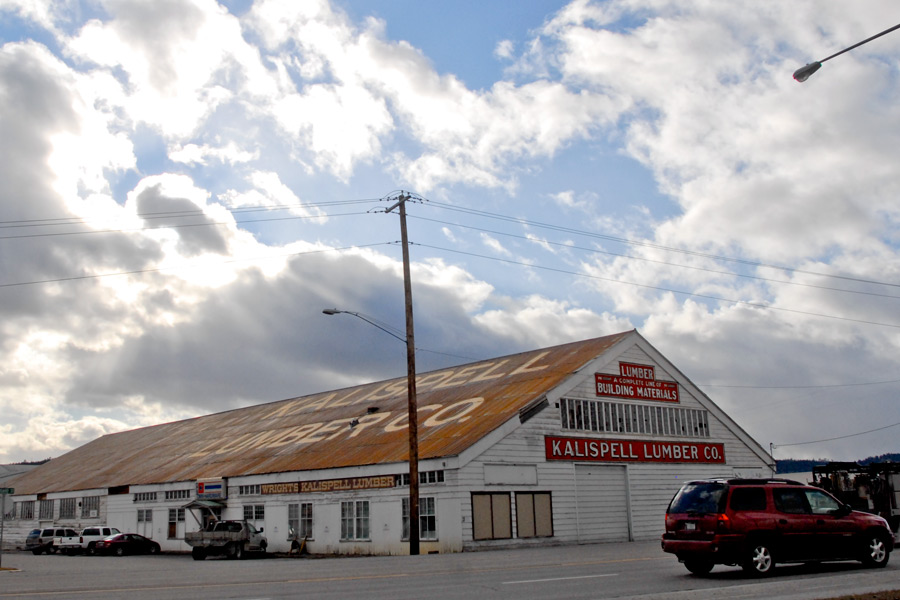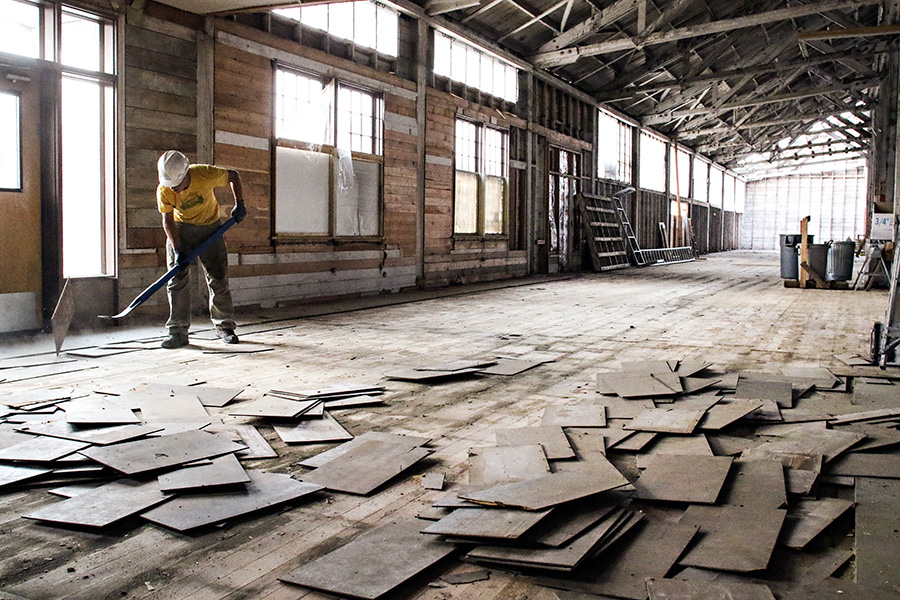The giant warehouse along Idaho Street, a rustic remnant emblazoned with an iconic and outsized reference to Kalispell’s timber tradition, is disappearing piece by piece from its prominent stature on the west side of town.
The original Kalispell Lumber Co. building, erected in 1939 in what was once the industrial heart of the Flathead Valley, is being carefully disassembled over the next few months. Tom and Kristin Davis have bought the 22,000-square-foot building from Brad Wright, whose family has owned it for more than 30 years, and the Davis’ are having it rebuilt at their property across town.
Last week Heritage Timber LLC, a Missoula-based deconstruction company, began the three-month process of dismantling the building, which encompasses roughly 220,000 board feet of wood. Much of the material is tight-grain, old growth wood cut in old-fashioned dimensions, including 10-by-12 foot posts, 22-foot-long beams and towering roof trusses that extend 35 feet into the sky.
An estimated 90 percent of the original structure is being preserved so that it can retain its historic identity after being rebuilt.
“We have dismantled over 300 buildings throughout Montana and helped preserve the rich legacy of Montana’s industries,” said Heritage Timber owner Gary Delp.
The Kalispell Lumber Co. building is certainly a relic from a bygone era. It has survived time and torment, including two major fires that consumed entire city blocks more than half a century ago. Its signature presence on the west side of town has been unmistakable to generations of passersby. And its relocation from plain view represents a stark trend: the fading visage of an economic stalwart that played a pivotal role in the valley’s origin story.
Before anything else, this was a timber town. By the turn of the 20th century, the arrival of the railroad had fostered a burgeoning timber empire in the forested mountains of Northwest Montana. By the early 1900s, there were 30 sawmills operating in and around Kalispell and producing 150 million board feet of lumber, according to U.S. Forest Service historical documents.
An advantageous man named Harry G. Miller arrived in the Flathead Valley around this time with dreams of capitalizing on the lumber rush.
According to Ronald Buentemeier, a former longtime staff member at F.H. Stoltze Land & Lumber Co. and an expert on the valley’s forestry roots, Miller rented a desk at the O’Neil Lumber Company office in downtown Kalispell and began selling lumber. Like many others, his enterprise grew with success and in 1923 he officially formed the Kalispell Lumber Company. He built the company’s first mill west of town near modern-day Kila in a community known as Batavia.
Miller quickly needed more space and wanted to be closer to the railroad, so he landed property on the western outskirts of Kalispell on an empty pasture of land across the road from the fairgrounds.
In 1926 he began erecting the new mill, a storage shed and mill pond with a spur that connected to the Great Northern Railway tracks. In the summer of 1926, the massive facility was completed and became one of the valley’s leading producers of fine timber products.

Alongside other successful outfits, such as Stoltze, Northwestern Lumber Co. and Somers Lumber Company, the Kalispell Lumber Co. helped put the Flathead Valley on the map. By 1928, Flathead County mills produced about 40 percent of the lumber manufactured in Montana, according to Forest Service records.
Yet success could not prevent volatility, both economically and logistically. The Great Depression hurt many local mills and reduced production almost to a complete halt. Just as damaging, the Kalispell Lumber Co. suffered two major fires, in 1939 and then again in 1949.
During the heat of the day on July 5, 1949, a fire broke out beneath the wooden floorboards of the planning shed. Flames quickly engulfed the shed and spread to the nearby warehouse, garage and boxcars, which were filled with lumber. Historic newspaper reports say the flames spread to the entire city block and required residents to evacuate and attracted the attention of the city’s entire fire department. The fire chief at the time said it was the largest incident the department had fought to date. The inferno threatened the sawmill as well as the building that still stands today, but crews were able to successfully fend off the flames, which roared for three days before being extinguished. Three buildings were reduced to ash, and the estimated damages exceeded $100,000.
By 1960, Miller’s son, Gilbert Miller, known by many as Pink, was running Kalispell Lumber Company. The Flathead Valley’s wood products industry languished under difficult economic conditions. Lumber prices fell at the same time nationwide housing starts dropped nearly 20 percent from two years prior.
By now a veteran lumberman, Miller painted a bleak picture in a story in the Daily Inter Lake in January 1961.
“I don’t have any outlook,” he said. “My crystal ball is broken.”
Later that year, on Sept. 29, 1961, Miller, in his 70s, announced the closure of the Kalispell Lumber Co. mill. Kalispell city councilors and chamber of commerce leaders had negotiated with Miller in an effort to prevent the shutdown but to no avail. Miller began selling the equipment on site and eventually listed the property. The closure led to more than 25 layoffs at the same time the Rocky Mountain Timber Company in Columbia Falls and FK and L mill in Martin City laid off employees due to the soft market.
New businesses replaced parts of the old lumber company, including a lineup of storage sheds to the south where the log yard once sat and a grocery store to the west along Meridian. The Wright family purchased part of the property along Eighth Avenue West North along Idaho Street and for decades operated the lumber yard and a hardware store, keeping intact what has been a lasting relic of the Millers and the early days of Kalispell. After closing Wright’s Kalispell Lumber, Brad Wright sought ways to preserve the building. And now, through the Davis’, its legacy will live on.
Correction: Harry Miller was the founder of the Kalispell Lumber Company. The story previously incorrectly stated that he was known as Pink. In fact, according to descendants, his son, Gilbert Miller, was known as Pink.
